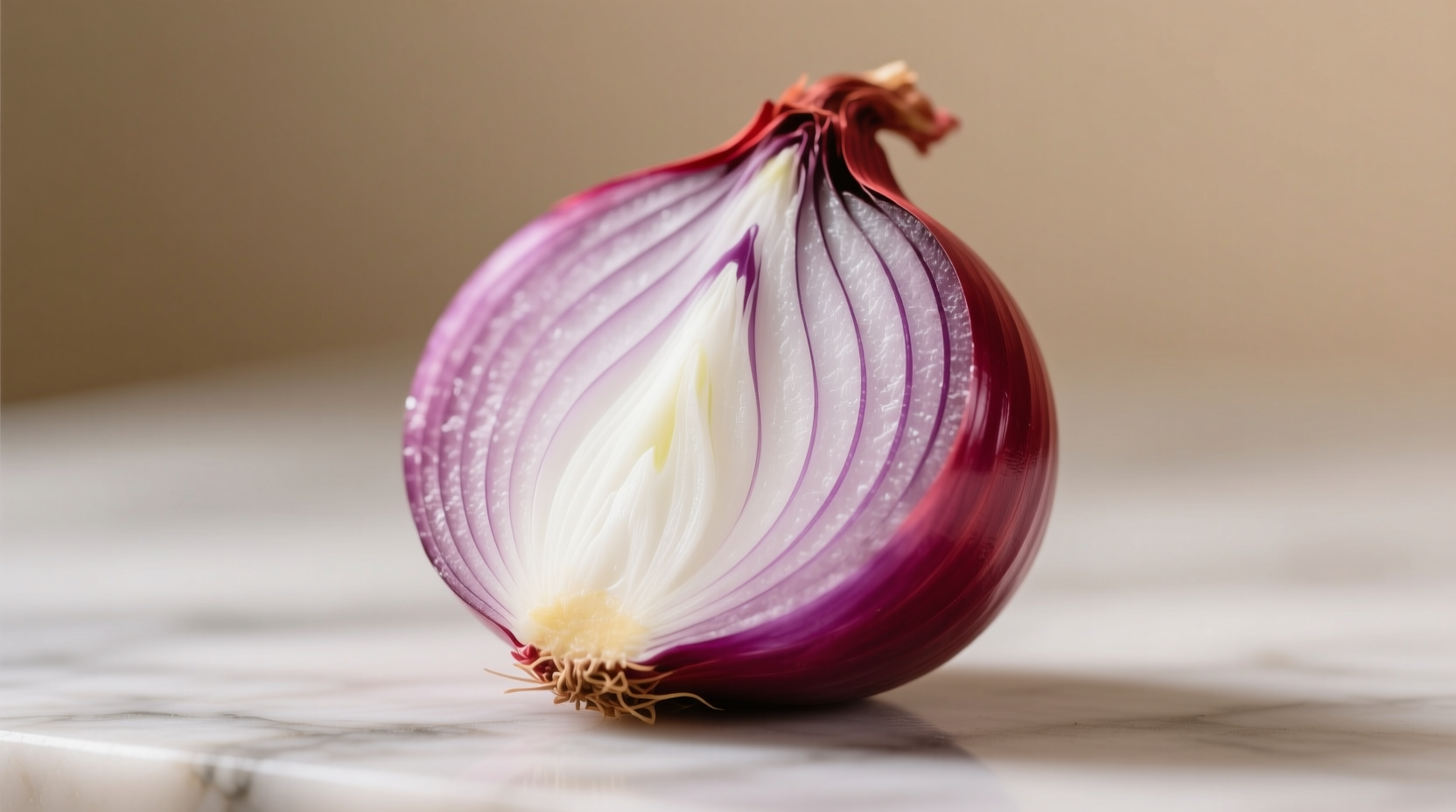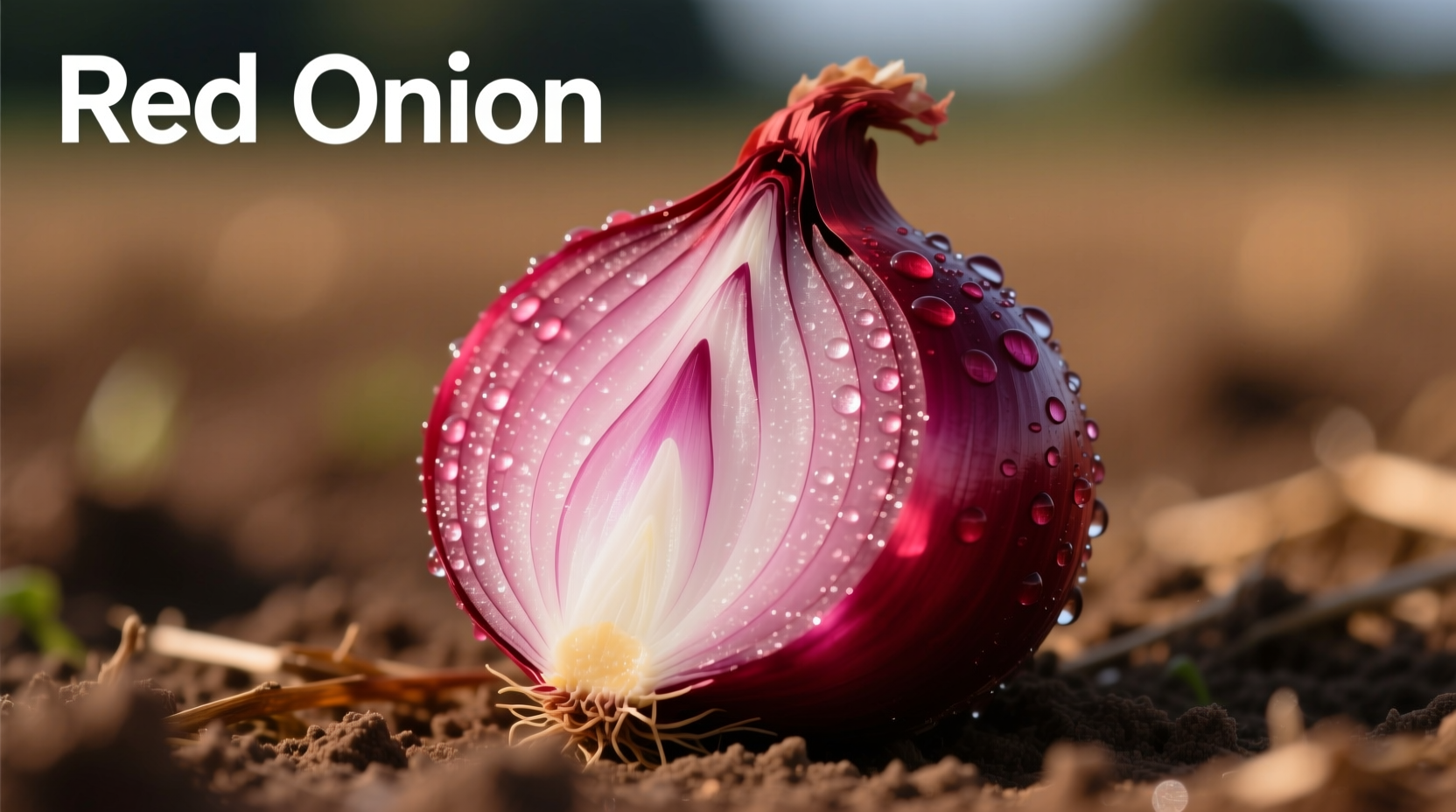When you reach for red onions in your kitchen, you're choosing a versatile allium that brings both visual appeal and balanced flavor to countless dishes. Unlike their yellow and white counterparts, red onions maintain their striking color when raw while delivering a flavor profile that's sharp enough to add dimension but mild enough to eat without overwhelming other ingredients. Understanding their unique properties helps you maximize their culinary potential while benefiting from their impressive nutritional profile.
The Essential Characteristics of Red Onions
Red onions, scientifically classified as Allium cepa var. aggregatum, feature deep purple-red skin and flesh that ranges from reddish to purplish-white. Their distinctive color comes from anthocyanins—powerful antioxidants also found in blueberries and red cabbage. These onions typically have a rounder shape compared to yellow onions and contain 6-8% sugar content, placing them between yellow onions (5-6% sugar) and sweet varieties like Vidalias (12-15% sugar) on the sweetness spectrum.
When selecting red onions at the market, look for firm bulbs with dry, papery skin free of soft spots or mold. The best specimens feel heavy for their size with minimal neck space between the layers. Unlike yellow onions that develop stronger flavor with age, red onions maintain relatively consistent flavor intensity throughout their shelf life.
| Onion Variety | Color Characteristics | Sugar Content | Best Culinary Uses |
|---|---|---|---|
| Red Onion | Purple-red skin and flesh | 6-8% | Raw applications, pickling, salads |
| Yellow Onion | Brown skin, white-yellow flesh | 5-6% | Cooking, caramelizing, soups |
| White Onion | Pale yellow skin, white flesh | 5-6% | Mexican cuisine, salsas, grilling |
| Sweet Onion | Light yellow skin, white flesh | 12-15% | Raw consumption, sandwiches, burgers |
Flavor Dynamics: How Red Onions Transform in Cooking
Red onions offer a unique flavor journey that changes dramatically based on preparation method. Raw, they deliver a crisp texture with a mildly sharp, slightly sweet flavor that's less aggressive than yellow onions. This makes them ideal for fresh applications where onion flavor should complement rather than dominate.
When cooked, red onions undergo fascinating transformations. Their anthocyanins react with alkaline substances, turning blue or green—a phenomenon you've likely noticed when adding them to bean salads with baking soda. High-heat cooking causes their color to fade to a pale pink, while slow caramelization develops a more complex sweetness than yellow onions due to their higher sugar content.
Professional chefs often employ a technique called "onion shocking" with red onions: slicing them thinly and soaking in ice water for 15-20 minutes before use. This process removes some of the sharp sulfur compounds while maintaining crispness, making them perfect for salads and sandwiches where you want onion flavor without overwhelming bite.

Nutritional Powerhouse: The Science-Backed Benefits
Red onions stand out nutritionally due to their anthocyanin content, which gives them superior antioxidant properties compared to other onion varieties. According to USDA FoodData Central, a 100g serving of raw red onion contains:
- 40 calories
- 9g carbohydrates
- 1.7g dietary fiber
- 17mg vitamin C (28% of daily value)
- 162mg potassium
- Significant quercetin and anthocyanins
Research published in the Journal of Agricultural and Food Chemistry confirms that red onions contain up to 25% more quercetin than yellow varieties. This flavonoid has been associated with reduced inflammation and improved cardiovascular health. The anthocyanins responsible for their purple hue have demonstrated anti-inflammatory and antioxidant effects in multiple clinical studies.
Unlike many vegetables that lose nutrients during cooking, red onions actually increase their antioxidant availability when cooked briefly. A 2020 study from the University of Guelph found that lightly sautéed red onions had 35% higher antioxidant bioavailability compared to raw, though prolonged cooking reduces these benefits.
Culinary Applications: Maximizing Red Onion Potential
Understanding when to use red onions versus other varieties separates novice cooks from those who consistently create balanced flavors. Here's how to leverage their unique properties:
Raw Applications Where They Shine
- Salads: Their vibrant color adds visual appeal while their moderate sharpness complements greens without overpowering
- Salsas and Pico de Gallo: Provides structure that holds up better than white onions while adding color contrast
- Burgers and Sandwiches: Offers milder bite than yellow onions, especially after a quick soak in ice water
- Pickling: Creates beautifully colored pickled onions that add visual interest to charcuterie boards and tacos
Cooking Techniques That Transform Them
- Quick Sauté: Cook over medium-high heat for 3-4 minutes to maintain some crunch while mellowing sharpness
- Caramelization: Takes slightly longer than yellow onions due to higher water content but develops a more complex sweetness
- Grilling: Slice 1/2-inch thick, brush with oil, and grill for 3-4 minutes per side for smoky-sweet flavor
- Roasting: Toss wedges with olive oil and roast at 400°F for 25-30 minutes for sweet, jammy results
Storage Secrets for Maximum Freshness
Proper storage dramatically extends red onion shelf life while maintaining flavor quality. Unlike yellow onions that prefer cool, dark places, red onions have different storage requirements due to their higher moisture content:
- Whole onions: Store in a cool, dark, well-ventilated place (not the refrigerator) for up to 3 weeks
- Sliced onions: Place in airtight container in refrigerator for 7-10 days
- Freezing: Chop and freeze in airtight bags for up to 6 months (best for cooked applications)
Agricultural research from Cornell University's Food Science Department shows that storing red onions at 45-55°F with 65-70% humidity preserves quality longest. Avoid storing near potatoes, which emit ethylene gas that accelerates onion spoilage. For optimal flavor retention, use red onions within 2-3 weeks of purchase as their flavor gradually intensifies over time.
When Red Onions Aren't the Right Choice
Despite their versatility, red onions have limitations. Understanding these context boundaries prevents culinary missteps:
- Long-simmered soups and stews: Their color bleeds and flavor becomes indistinct compared to yellow onions
- Recipes requiring pure white appearance: Their color can tint dishes (though this is often desirable)
- When maximum sweetness is required: Sweet onions like Vidalias outperform in raw applications
- High-heat searing: Their higher water content causes more splattering than yellow onions
When substituting, use 3/4 cup chopped red onion for every 1 cup yellow onion called for in cooked dishes. For raw applications, adjust to taste as red onions provide more visual impact but slightly less pungency.











 浙公网安备
33010002000092号
浙公网安备
33010002000092号 浙B2-20120091-4
浙B2-20120091-4